14 Screening Trees For Privacy
In most gardens, trees provide structure and seasonally changing interest. Using trees for screening out or hiding an undesirable view can provide some privacy in the garden as well as a calming retreat from the busy world. We present fourteen of the best trees for privacy from neighbours or undesirable views.
Then you can make these trees an ideal focal point, so that your families and future generations can enjoy them for years to come.
Often, above fence screening trees have a clear stem that reaches up to fence panel heights of about 1.8-2m, surrounded by a dense canopy above. In particular, this type of screening is useful if your property is overlooked by neighbouring properties, if you would like to draw attention to an attractive feature, or if you would like to maintain lower exposure, such as to a wall or area.
When planting for this purpose, evergreens are generally preferred and can be planted densely to gain maximum effect from the beginning. Alternatively, if space permits, planting a variety of trees can provide a rich contrast and seasonal interest.
A screen that contains a row of two or more evergreens could be considered a high hedge.
Prior to the Anti-Social Behaviour Act 2003: Part 8 in 2005, the term ‘high hedges’ was considered subjective. The following is a brief summary of what the law states about high hedging:
- There is extra guidance for hedge heights on slopes if the hedge is more than 2 meters tall (about 6ft 5inches).
- The definition of a hedge under law is a line of trees or shrubs consisting of two or more.
- Hedges are made up of trees and shrubs that are either evergreen (those that don’t lose leaves in the winter) or semi-evergreen (those that remain green for most of the year)
- Neither bamboo nor ivy are included
- In the case of a hedge predominantly composed of evergreen trees and shrubs, the work specified can also include the deciduous trees and shrubs within the hedge. If the council so wishes, specific trees may be excluded or different work may be required.
Consider these factors before selecting your screening trees for garden privacy:
It is impossible to find the perfect trees for screening, it is, however, possible to select the perfect tree for the privacy of your garden. There are alternatives to using trees as privacy screens.
As always, the starting point is your climate, your soil, the size and type of your garden, and the plants that grow well there. For tips on choosing the right tree for your garden, read this article on how to make a short list of perfect-for-privacy trees. There are even screening trees for small gardens, just research a tree before buying it to see it’s full height and spread.
There is no need to plant an entire row of trees every time. Only one tree is needed to block the view of your garden when only one neighbouring window can see it. That tree should be placed between your garden and that window. Learn more about creating garden privacy.
How to choose screening trees?, find your ideal tree
Ask your tree supplier how fast it will grow and how tall it will be. Young trees are usually more affordable and have a better chance to establish themselves. In the meantime, consider how fast the tree will grow if you want privacy soon.
It will be very expensive to buy mature specimens instead of a semi mature tree. However, you might have to wait many years before young trees reach their full potential depending on there rate of growth. So if your budget is tight look for fast growing screening trees.
Check your soil type, is it appropriate for the trees that you are considering to plant.
1. English Holly – Ilex aquifolium
The English Holly is a native evergreen screening tree with characteristic spikes on young plants, and smooth leaves on mature plants. In the spring, small white flowers bloom on Ilex aquifolium. After the first frosts of the year, birds and small mammals can eat the bright red berries. In the beginning, Holly grows slowly, eventually growing into a pyramidal shape. Holly thrives best in well-draining soil and is not likely to thrive in soils that hold a lot of water.
2. Holm Oak – Quercus ilex
The leaves of the Holm Oak, also called the Holly Oak, have leathery serrations and resemble holly leaves. In time, it forms a dense screen that lasts all year round after pruning. This tree is a magnificent evergreen, hardy and resilient; it is resistant to sea salt-spray as well as urban pollution. Thrives in most soils, coastal regions and urban areas, it can grow up to a height of 25 metres.

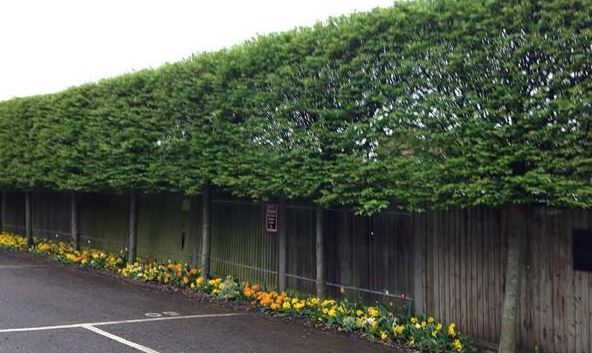
The Holm Oak is a great option if your looking for above fence screening trees for your garden.
3. Cypress Oak – Quercus robur Fastigiata Koster
There is no doubt that the Cypress Oak tree forms a regular and narrow crown, making it the ideal tree to plant in areas with limited space. There is no more beautiful tree in nature than a deep lobed, glossy green oak tree; the leaves turn golden brown in the autumn and are still attached to the tree in less exposed climates during the winter. Although it is suited for most soil types, it is especially suited to soils that have a heavy clay content. They have been know to reach 15 metres in height.
4. Lombardy Poplar – Populus nigra Italica
Lombardy poplars are narrowly columnar deciduous trees that make good screening trees and do well along riversides. These architectural columnar trees have crimson male catkins that open before they grow their bright green ovate leaves in the spring. It tolerates most soils including wet ones in the winter.
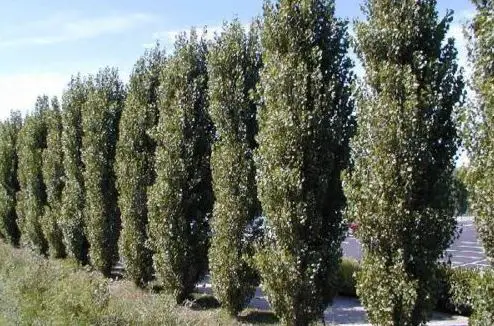
5. Magnolia Bull bay – Magnolia grandiflora Gallisoniensis
Magnolia Bull Bay bears large, shiny, white flowers that are up to 25 centimetres in diameter in the summer. The blossoms on this beautiful tree don’t just look amazing; they emit a sweet, citrusy scent as well. These plants have large, ovoid leaves that are dark green on top and coppery on the underside. Initially, its young leaves are reddish, then turn greyish brown with maturity. As a screening plant as well as an attractive ornamental feature, Bull Bay is characterized by its large leaves and bushy head. For best results, protect from northerly exposure, it grows well in most soils and can reach a height of 15 metres.
6. Cherry Laurel – Prunus laurocerasus
The upright and bushy habits of Cherry Laurel make it ideal for screening. In addition to small, sweet-smelling, white flowers, this plant produces vertical racemes that reach about 12 cm in length, followed by small cherries-like fruit. It prefers moist, slightly acidic soil in full sunlight to partial shade.
7. English Yew – Taxus baccata
There are few trees as elegant or long-lived as the English Yew. The leaves are small, dark green, and arranged in whorls on the branches. Each seed is enclosed in a red, fruit-like aril with an open end, giving these trees additional interest. Pruning Taxus baccata in early spring rejuvenates the tree greatly. Does best in lighter soils that drain freely.
You can use this tree to create an almost solid green wall with its dense foliage, , this makes the English Yew one of the best privacy trees out there.
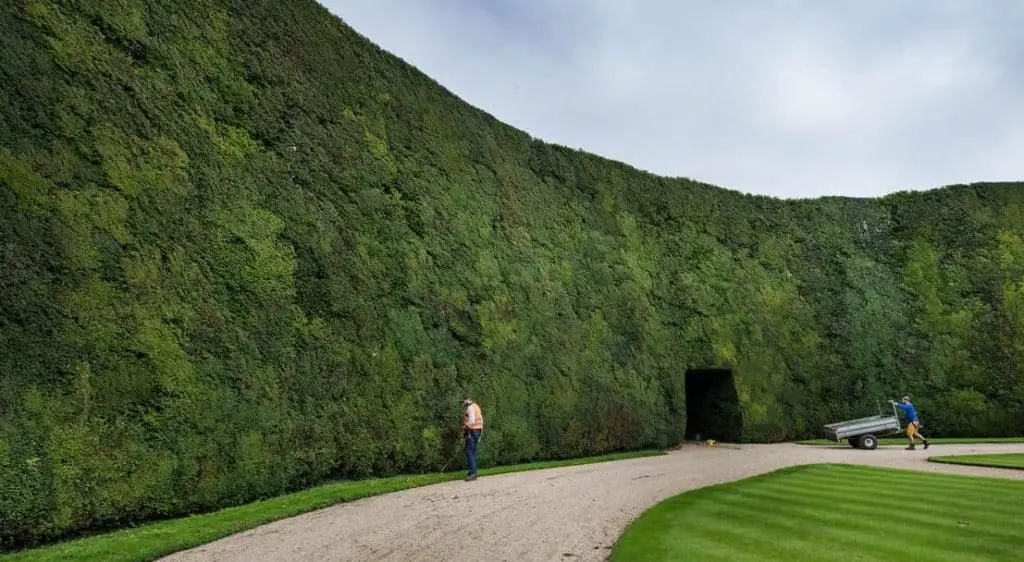
8. Western Red Cedar – Thuja plicata
Western Red Cedars are impressive evergreen conifers with dense branches, which make them excellent screening trees. Their dark-green glossy scales are delightfully aromatic. Thurjas are generally frost-hardy and tolerant of urban pollution.
9. Lombardy Poplar – Populus nigra Italica
Lombardy poplars are narrowly columnar deciduous trees that make good screening trees and do well along riversides. These architectural columnar trees have crimson male catkins that open before they grow their bright green ovate leaves in the spring.
10. Hornbeam – Carpinus betulus
A deciduous tree with the ability to regenerate after being pruned, hornbeams are ideal for screening, whether pleached or as a natural fastigate/column. Its leaves turn golden yellow in autumn and have a green color in spring, with its trunk being vertical and the bark smooth and dark grey.
11. Snowy Mespilus / Juneberry – Amelanchier lamarckii
‘Anelanchier lamarckii’ is an erect, deciduous shrub or tree with a bronze-tinted foliage that turns red and orange in autumn. In the unfurling of the leaves, white flowers form lax racemes. The fruits are red to dark purple berries, readily eaten by birds.
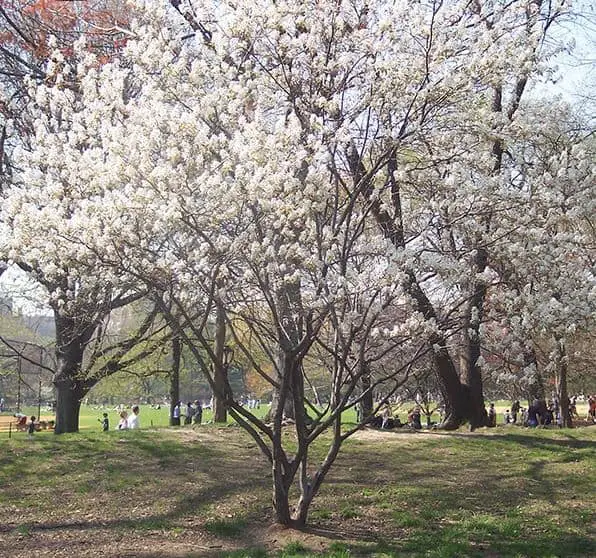
12. Leyland cypress – Cuprocyparis leylandii
A dense, fast-growing, evergreen conifer with a columnar habit that can exceed 30m in height if left unchecked. Its leaves look like scales and form flattened, slightly drooping sprays when they are densely packed. If your looking for fast growing screening trees then this is the one for you. Leyland Cypress is the the fastest growing evergreen that you can get, it can grow up to 90cm per year.
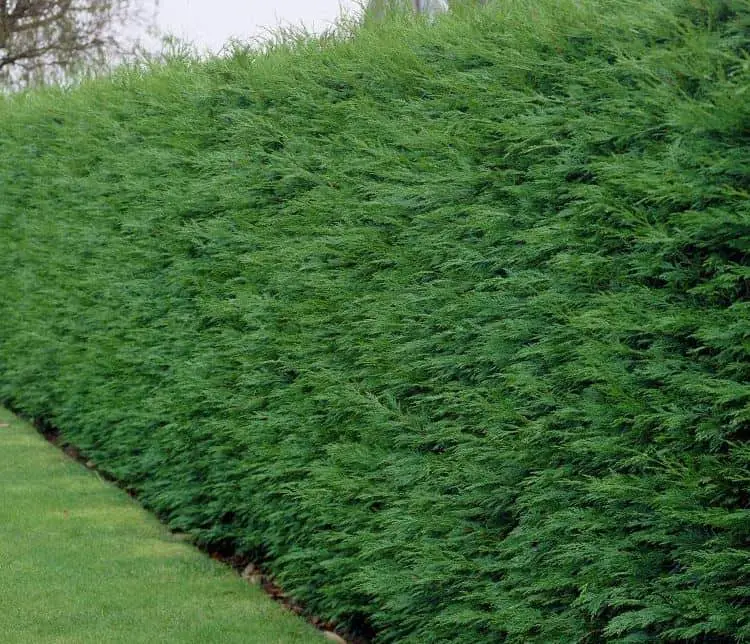
13. Japanese privet – Ligustrum japonicum
A tall, upright evergreen shrub, or a small tree, the height of which is around 3m when grown as a shrub. There are waxy dark green leaves that measure a maximum of 4cm long and are dark green in colour. Mid-summer to early autumn, this shrub or small tree is covered in conical sprays of small, fragrant, off-white flowers and small, round, black berries which birds love to eat.
14. Red Robin – Photinia fraseri
An evergreen shrub with elliptical leaves up to 10 cm long that are bright red when the leaves are young, and later turn dark green as they age. It produces a few cream-white flowers.
Red Robin trees for screening can be used in numerous ways as a pleached tree, standard or half standard.
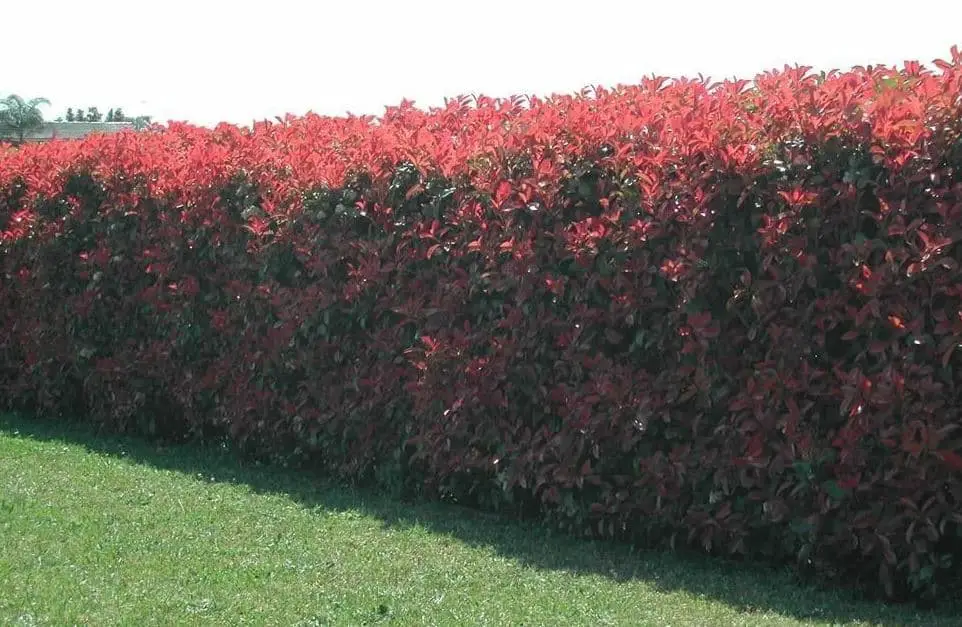
Here is a helpful video showing you potential ideas for evergreen screening trees in your garden.
